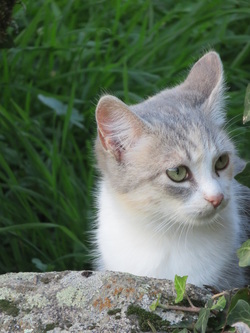
The two young females are around 5 months old and should be spayed soon (Butterfly Cat here is one). As we are not going to be around to organise this until probably the new year, they would then be 7 months old and likely to be pregnant. I have been reading up on the various feral cat advice sites (there are loads and seem to be mainly from the US) and they agree that 5 months is not too young, some even say spaying can be done at 4 months or younger. Of course this is different to the accepted wisdom about domestic cats where the advice is usually to spay at 6 months. But that situation is where you may have control over the cat, or the cat might have the protection of a home or humans. In the case of ferals they have no protection at all. For more on this see www.feralcats.com/feral-kittens
So we stopped off to talk to the local vet today and agreed to bring in these two this week. We will also speak with him about Tortipizza. She can't eat dry food as she has a problem with her mouth. She eats the tinned food that we give her and the macaroni that the neighbours provide, if she can get to it before the others. So we really need to find out if there is something going on with her teeth or jaw that surgery could fix. I tried several times to catch her last time we were here but she is very wary of the traps (having had that experience once around 5 years ago when she was neutered!). She has a long memory that one, and is a smart cookie. If only we could explain that we want to help her! I am hoping a 'delicious' paste treat, called 'Gimpet' (sounds and smells disgusting) I have brought with me will do the trick to get her into a trap.
Finally, we want to set up two plastic boxes I bought, as houses for the winter. I bought some large polystyrene boxes a few years ago which were purpose built for feral cats, with cat flap size doors and two chambers inside. We put them on bricks so they are off the floor, in one of the abandoned houses. We have no idea if they have been used. They are still there and if you lift the lid there appear to be signs of activity, grit and bits of leaf but no obvious fur. Who knows? I read today that cats whose ears are turned over on the tips could have had frostbite. We have a few of these here, the tail-less cat for example. I thought it was genetic but perhaps it was frostbite! This underlines the importance of warm shelters during the winter. The plan for the new plastic boxes, which are 'blanket box' size, is to cut catflap shape holes in either end and line with a few tight fitting layers of cardboard. We're hoping this will give some insulation. I am sure they curl up in a big heap for warmth, and quite a few cats will fit in these. Adam is not convinced they'll use them, and I hope to prove him wrong! Eventually I would like to build a proper outside shelter based on a shed design, but we haven't managed that yet.

 RSS Feed
RSS Feed